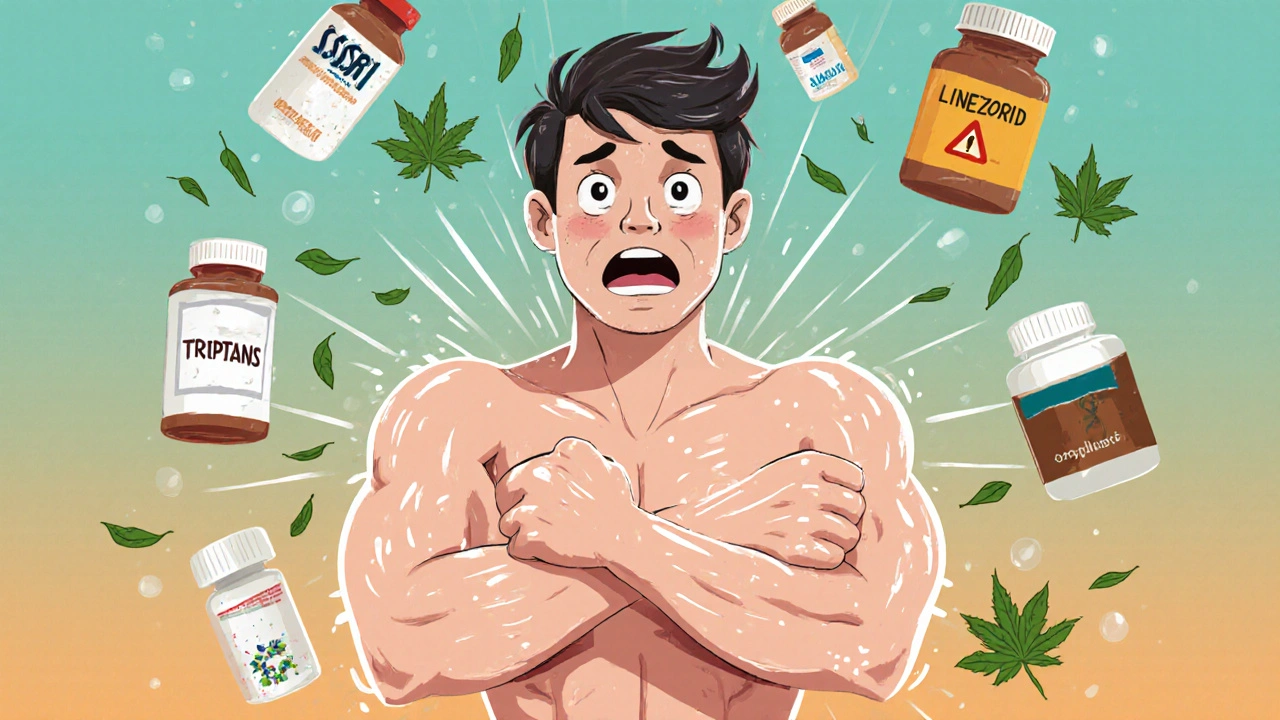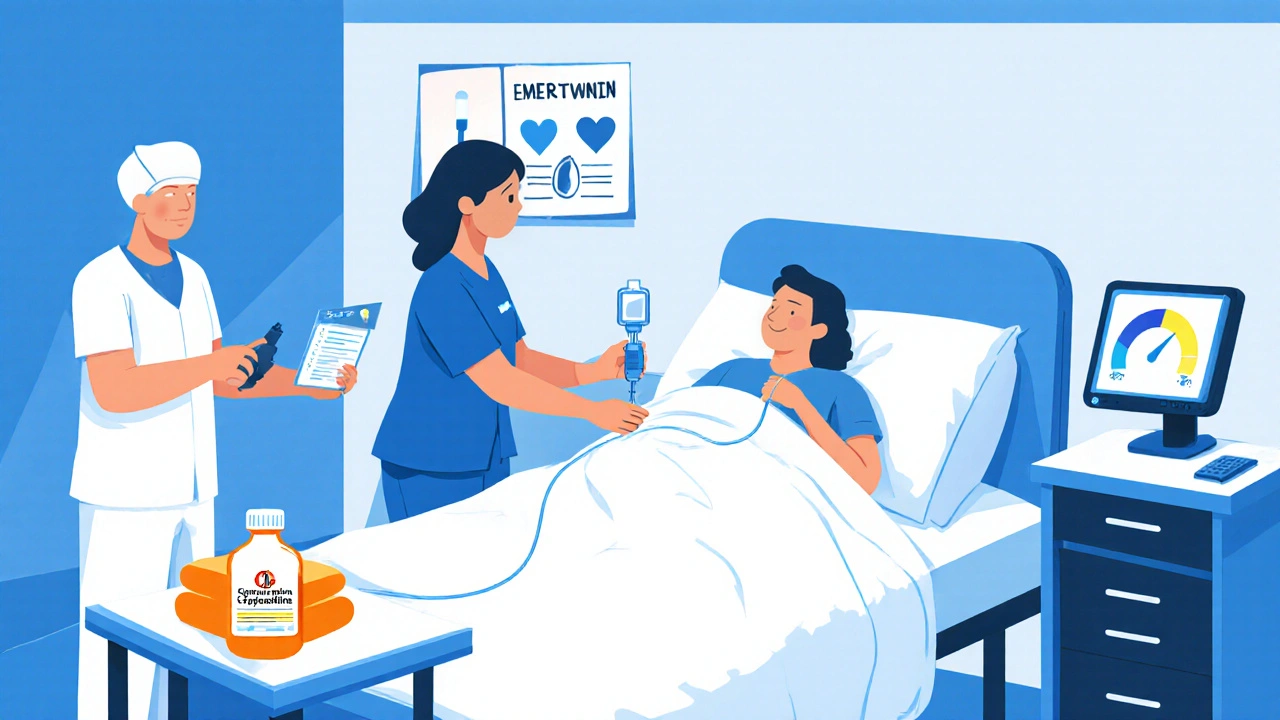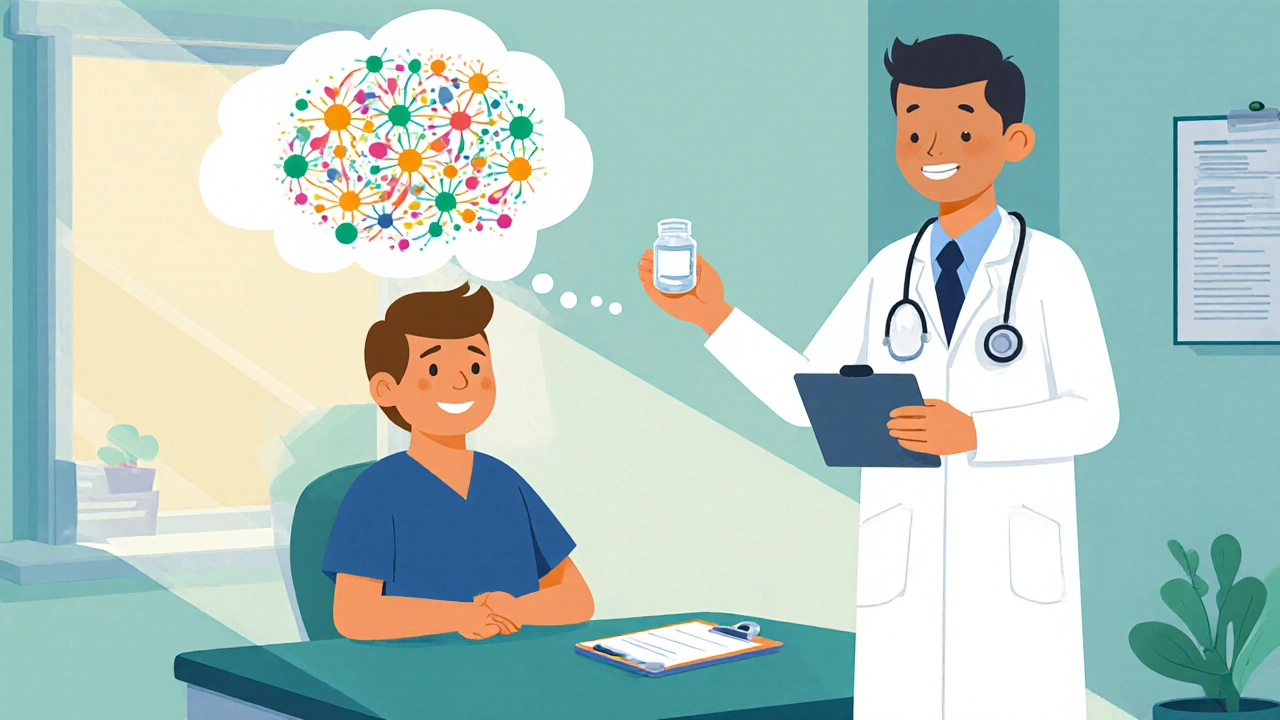Serotonin Syndrome Risk Assessment Tool
Select Medication Combination
Tricyclic antidepressant with dual serotonin and norepinephrine reuptake inhibition
Risk Assessment Results
Select a medication combination to see the risk assessment
Early Warning Symptoms
Monitor for: agitation, hyperreflexia, sweating, confusion, fever, rapid heart rate
Key Takeaways
- Dosulepin, a tricyclic antidepressant, can trigger serotonin syndrome when combined with other serotonergic agents.
- Early signs include agitation, hyperreflexia, and sweating; severe cases may lead to seizures or organ failure.
- Identify high‑risk drug combinations and monitor plasma levels, especially with CYP2D6 inhibitors.
- Immediate discontinuation and supportive care, plus cyproheptadine, are the mainstays of treatment.
- Patient education and regular review reduce the likelihood of accidental overdose.
When a prescriber mentions Dosulepin as a treatment option, many patients wonder how it differs from newer antidepressants. One hidden danger is its potential to spark serotonin syndrome, a potentially life‑threatening reaction that mimics an allergic response but stems from excess serotonin activity in the brain and peripheral nervous system. This guide walks you through what serotonin syndrome is, why dosulepin matters, which drug combos raise red flags, and how clinicians tame the reaction when it erupts.
Dosulepin is a tricyclic antidepressant (TCA) that blocks the re‑uptake of both serotonin and norepinephrine, boosting their levels in the synaptic cleft. First approved in the UK in the 1970s, it is marketed under the brand name \"Prothiaden\" and remains a go‑to for patients who do not respond to selective serotonin re‑uptake inhibitors (SSRIs). Its pharmacokinetic profile features a half‑life of 20-30hours and metabolism primarily via the cytochrome P450 enzyme CYP2D6. Serotonin Syndrome is a clinical syndrome caused by excessive serotonergic activity at central and peripheral 5‑HT receptors. It presents with a triad of cognitive (confusion, agitation), autonomic (hyperthermia, diaphoresis), and somatic (hyperreflexia, clonus) symptoms. The condition can develop within minutes of a drug dose change or overdose, and early recognition is crucial for a favorable outcome.How Dosulepin Contributes to Serotonin Excess
Dosulepin raises serotonin levels by hindering its re‑absorption. When taken alone at therapeutic doses, most patients tolerate this increase without severe issues. The problem arises when another serotonergic drug-such as an SSRI, a monoamine‑oxidase inhibitor (MAOI), or even an over‑the‑counter supplement like StJohn’s wort-is added. The combined effect can push serotonin activity beyond the safety threshold, triggering the syndrome.
Key pharmacological factors include:
- Dual re‑uptake inhibition: Dosulepin blocks both serotonin and norepinephrine re‑uptake, amplifying serotonergic tone.
- CYP2D6 metabolism: Inhibitors of this enzyme (e.g., fluoxetine, paroxetine) raise dosulepin plasma concentrations, increasing serotonin spillover.
- Active metabolites: Desmethyldosulepin retains serotonergic activity and can accumulate in renal impairment.
Common Drug Combinations that Heighten Risk
Not all drug combos are equally dangerous. Below is a quick reference of agents that, when used with dosulepin, have the strongest evidence for precipitating serotonin syndrome.
| Drug Class | Typical Agent | Mechanism Raising Serotonin | Relative Risk with Dosulepin |
|---|---|---|---|
| SSRIs | Fluoxetine | Potent serotonin re‑uptake inhibition | High |
| MAOIs | Phenelzine | Blocks breakdown of serotonin | Very High |
| SNRIs | Venlafaxine | Inhibits serotonin and norepinephrine re‑uptake | Moderate‑High |
| Triptans | Sumatriptan | Stimulates 5‑HT₁B/₁D receptors | Moderate |
| Linezolid (antibiotic) | Linezolid | Reversible MAO inhibition | Moderate‑High |
| Herbal supplements | StJohn’s wort | Increases serotonin release | Low‑Moderate |

Recognizing the Early Signs
Serotonin syndrome can masquerade as anxiety or a flu‑like illness, which is why clinicians rely on a systematic grading tool-the Hunter Serotonin Toxicity Criteria. According to this algorithm, the presence of any one of the following after serotonergic drug exposure confirms the diagnosis:
- Spontaneous clonus
- Inducible clonus + agitation or diaphoresis
- Ocular clonus + agitation or diaphoresis
- Hypertonia + temperature >38°C + ocular or inducible clonus
- Serotonin‐specific medication + agitation + diaphoresis
Typical progression starts with mental status changes (confusion, agitation), followed by autonomic instability (fever, rapid heart rate), and then neuromuscular hyperactivity (hyperreflexia, clonus). In severe cases, seizures, rhabdomyolysis, and multi‑organ failure can develop within hours.
Step‑by‑Step Management Protocol
When serotonin syndrome is suspected, time is of the essence. Below is a concise, actionable protocol that emergency physicians and primary‑care doctors can follow.
- Stop all serotonergic agents immediately. This includes the offending dose of dosulepin and any adjunctive SSRI or MAOI.
- Supportive care. Provide oxygen, secure airway if needed, and initiate IV fluids to maintain perfusion.
- Control hyperthermia. Use external cooling blankets; avoid antipyretics alone because fever is driven by neuromuscular activity.
- Administer serotonin antagonists. Cyproheptadine 12mg PO loading dose, then 2mg every 2hours until symptoms abate (max 32mg/day).
- Manage agitation. Benzodiazepines (e.g., lorazepam 1-2mg IV) calm the patient and reduce muscle rigidity.
- Monitor labs. Check creatine kinase (CK) for rhabdomyolysis, electrolytes, liver enzymes, and renal function.
- Observe for at least 24hours. Symptoms may recur after the antagonist wears off; continued monitoring is essential.
After stabilization, reassess the antidepressant regimen. Switching to a non‑serotonergic agent-such as a norepinephrine‑dominant antidepressant (e.g., reboxetine) or a low‑dose atypical antipsychotic-may be safer for patients who previously required dosulepin.

Preventive Strategies for Clinicians
Prevention beats treatment every time. Here are concrete steps to lower the chance of serotonin syndrome when prescribing dosulepin:
- Medication reconciliation. Review the patient’s full drug list, including OTC meds and supplements, before initiating dosulepin.
- Avoid concurrent MAOIs. A minimum 14‑day washout period is recommended after stopping an MAOI before starting dosulepin, and vice‑versa.
- Check CYP2D6 interactions. If the patient is on a strong CYP2D6 inhibitor, consider dose reduction or a different antidepressant.
- Start low, go slow. Begin with 25mg at bedtime; titrate up by 25mg increments weekly while monitoring for side effects.
- Educate patients. Explain warning signs-sudden sweating, tremor, or confusion-and advise immediate medical attention.
Case Illustration: A Real‑World Scenario
Emma, a 42‑year‑old teacher from Birmingham, had been on dosulepin 150mg for chronic depression. Her GP added fluoxetine 20mg to address lingering anxiety, unaware of the interaction. Within three days Emma experienced severe restlessness, profuse sweating, and clonus in her ankles. She was rushed to the emergency department where the clinical team applied the Hunter criteria, recognized serotonin syndrome, and started cyproheptadine. After 12hours, her temperature normalized, and the clonus resolved. Emma’s treatment plan was revised to discontinue both serotonergic drugs and switch to mirtazapine, a noradrenergic‑and‑specific antidepressant with minimal serotonin impact.
This case highlights how a seemingly modest dose addition can tip the balance, underscoring the need for vigilant prescribing and patient education.
Frequently Asked Questions
Can a single dose of dosulepin cause serotonin syndrome?
It is rare for a single therapeutic dose of dosulepin to cause the syndrome on its own. The risk rises dramatically when combined with other serotonergic agents or when metabolism is impaired.
Is serotonin syndrome the same as a drug overdose?
An overdose can include serotonin syndrome, but not all overdoses produce it. Serotonin syndrome specifically stems from excess serotonin activity, whereas overdose toxicity may involve many other pathways.
How long does it take for symptoms to disappear after stopping dosulepin?
Mild symptoms usually improve within 24hours once the drug is withdrawn. Severe cases may require several days of supportive care and antagonist therapy.
Are there any genetic tests to predict serotonin syndrome risk?
Testing for CYP2D6 polymorphisms can reveal poor metabolizer status, which raises dosulepin levels and risk. However, no single test guarantees prediction of serotonin syndrome.
What should I do if I suspect serotonin syndrome at home?
Stop any serotonergic medication immediately and seek emergency medical help. Do not wait for symptoms to worsen; early intervention saves lives.
Understanding the link between dosulepin and serotonin syndrome empowers both prescribers and patients to make safer choices. By recognizing high‑risk combinations, watching for early warning signs, and acting swiftly, the severe consequences of this condition become avoidable.


Comments (17)
Robert Gallagher
October 19, 2025 AT 06:48This is the kind of post that saves lives. I've seen too many patients get mixed up on SSRIs and TCAs. Just stop the combo and give cyproheptadine. Done. No drama.
But seriously, if your doc prescribes dosulepin and fluoxetine together? Run.
Howard Lee
October 20, 2025 AT 07:45I appreciate the clarity of this guide. The Hunter Criteria breakdown is especially helpful for primary care providers who don't see serotonin syndrome often. I've used this protocol in the ER and it works exactly as described. Cyproheptadine is underutilized.
Nicole Carpentier
October 20, 2025 AT 12:16I'm a nurse in Chicago and I've seen this happen twice. One guy took St. John’s wort with his dosulepin because he 'didn't trust big pharma.' He ended up in ICU. Please educate your patients. This isn't theoretical. It's real. And it's scary.
Hadrian D'Souza
October 22, 2025 AT 08:21Oh look, another 3000-word textbook chapter disguised as a Reddit post. Did you get paid by Lundbeck to write this? Dosulepin is a 1970s relic. The fact that it's still prescribed in the UK while we have esketamine and ketamine derivatives says more about healthcare stagnation than patient need. Also, 'cyproheptadine' sounds like a villain in a Marvel movie.
Brandon Benzi
October 24, 2025 AT 00:07This is why America is falling apart. We let some European relic drug stay on the market while banning perfectly good stimulants. And now we're teaching doctors to treat side effects instead of just prescribing the right drug from the start. This isn't medicine, it's triage.
Abhay Chitnis
October 24, 2025 AT 10:59Bro this is so true 😭 I had a cousin in Delhi who took dosulepin + curcumin + ashwagandha and ended up in hospital. No one told him any of this. India needs better doctor education. Also, CYP2D6 testing should be mandatory here. #PharmaIsWatching
Robert Spiece
October 25, 2025 AT 02:10So we're treating symptoms with more drugs? Cyproheptadine is an antihistamine. We're not curing the problem-we're just patching the hole while the whole ship sinks. The real question is: why are we still using drugs that require this much babysitting in the first place? We're not fixing the system. We're just making it more complicated.
Vivian Quinones
October 26, 2025 AT 12:42I don't trust any of this. My cousin took Prozac and it made her cry all day. Now you're saying dosulepin is worse? I think doctors just want to sell pills. Why not just meditate? Or go outside? My grandma never took antidepressants and she lived to 98.
Eric Pelletier
October 28, 2025 AT 03:52For those unfamiliar with CYP2D6 pharmacogenomics: poor metabolizers (PMs) have ~7% population prevalence in Caucasians and up to 20% in East Asians. In PMs, dosulepin AUC can increase 3–5 fold. This isn't just theoretical-it's a pharmacokinetic time bomb. Always consider genotyping if polypharmacy is involved. Also, desmethyldosulepin has a half-life of 50+ hours. That's why monitoring lasts 24–72 hours. Not 24.
Marshall Pope
October 28, 2025 AT 17:49this post is legit helpful. i had no idea st johns wort could do this. i was taking it with my zoloft and now i get why i felt so weird. thanks for the heads up
Nonie Rebollido
October 29, 2025 AT 08:19huh. i never thought about supplements being dangerous like this. i take turmeric and omega-3 every day. guess i'm gonna google if they interact with my meds 😅
Agha Nugraha
October 29, 2025 AT 15:20This is a really solid summary. I work in a rural clinic in Indonesia where TCAs are still common due to cost. This kind of clarity helps us avoid disaster. Thank you.
Andy Smith
October 31, 2025 AT 04:08I’d like to add that the 14-day washout period between MAOIs and dosulepin is non-negotiable-and it’s often ignored. Also, cyproheptadine isn’t FDA-approved for serotonin syndrome, but it’s the gold standard off-label. Many hospitals stock it now because of cases like Emma’s. And yes, reboxetine is an excellent alternative-underused, but effective. Don’t forget to check renal function before dosing, especially in elderly patients.
Rekha Tiwari
November 1, 2025 AT 10:06This is so important 💗 I work with teens in Mumbai and so many are self-medicating with herbal stuff because they think it's 'natural' and safe. This post should be shared in every school, every college, every pharmacy. We need more awareness, not more pills. Thank you for writing this! 🙏
Leah Beazy
November 3, 2025 AT 03:53I was on dosulepin for a year. My doctor added Wellbutrin because I was 'still tired.' I didn't know it was risky. I started sweating like crazy and felt like my muscles were vibrating. I thought I was having a panic attack. Took me three days to figure out what was wrong. This post is exactly what I needed back then.
John Villamayor
November 4, 2025 AT 17:02I’m from Texas and we don’t use dosulepin here much. But I’ve seen people on SSRIs and then go on tramadol for back pain. Boom. Serotonin syndrome. It’s not just the big drugs. It’s the little ones too. Always ask about everything. Even that tea your aunt swears by.
Jenna Hobbs
November 6, 2025 AT 14:38I’m a psychiatric nurse and I’ve watched people go from laughing to seizing in under an hour. This isn’t a 'maybe.' It’s a 'do not miss.' If you see clonus, don’t wait. Don’t run labs first. Give cyproheptadine. Give benzodiazepines. Cool them down. Save the paperwork for later. Lives depend on speed. Thank you for reminding us.